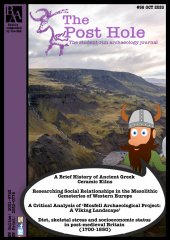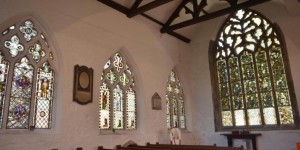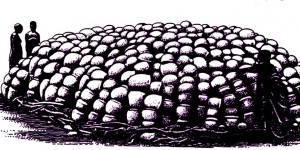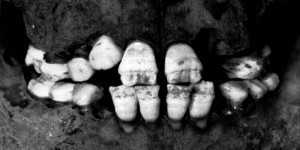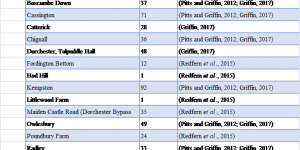Introduction
The role of heritage visualisation is to present archaeological data engagingly and accurately, incorporating sensory elements where possible. Visualisations take many forms, from illustrations (Piggott 1965) to multi-sensory GIS (Eve 2017), but one of the most popular is film, offering as it does a dynamic approach, with opportunities to incorporate visual and auditory elements. Struever (2009, 196) even describes it as “the most effective means of communicating the activities and tone of an archaeological excavation to a broad audience.” However, there are many pitfalls associated with the format. The relationship between archaeologist and film-maker can be fraught (Schlabitsky & Hetherington 2011, 141), and even where the archaeologist is the film-maker they must balance narrative with archaeological evidence to ensure both are equally represented (Morgan 2015, 330). Some of these issues, particularly the authority of narrative over evidence, may be observed in the following study.
‘Mosfell Archaeological Project: A Viking Landscape’ (Ross 2004) is a 16 minute long video concerning a season’s excavations at the Viking settlement site of Mosfell, Iceland, led by project directors Jesse Byock of UCLA and Phillip Walker of UCSB. Released in 2004, the video was written and filmed by Steve Ross and edited by Par Parekh, with on-screen contributions from Phillip Walker, Jon Erlandsson, Per Holck, Dagfinn Skre, and Mark Tveskov, as well as several unnamed contributors. The scripted elements are delivered and presumably written by Byock, based on his team’s research. The majority of the material, however, is delivered in the form of talking head interviews and on-site discussions between the other researchers. This critique will assess the authorship, audience, and transparency of the documentary, before discussing a potential alternative format for the information.
Audience & Engagement
It is unclear for whom exactly this video was made. It was copyrighted in 2004 by Steve Ross, and is available on the official project website on a page last updated in 2011 (Byock 2011). It is also on YouTube in two formats - the entire documentary from April 2013, and the same footage split into 6 parts from June 2007 - via Byock’s own account (Viking Language Old Norse 2007, 2013). Aside from these uploads, it is unclear how and where the video was disseminated. It does not appear to have been broadcast on television at any point and, at just under 16 minutes, it is not sufficient to act as a standalone TV documentary.
The presenters assume a basic knowledge of the Viking Age, but aside from that the video is aimed at an audience with interest but no expertise. The language avoids technical jargon, and deep examination of the archaeological evidence is eschewed in favour of a grander narrative more likely to appeal to the general public. Processes such as osteological analysis are addressed in a broad manner, explaining their potential to elucidate factors such as disease without expanding on techniques or issues.
Analysis
To engage the audience, Mosfell takes several different approaches. It largely follows the pattern of what Morgan (2015, 329-330) describes as an “expository” film, complete with “long shots of the landscape set to genteel flute music” - although the instrument in this case is an oboe (Fig. 1). It also fits into Kulik’s (2006, 84) category of a “backstage” view of contemporary excavation, showing ‘behind the scenes’ features; although, as shown below, these ‘behind the scenes’ aspects are used in a somewhat abstract manner.
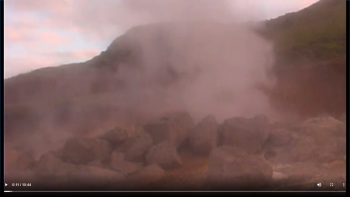
Following twenty seconds of landscape shots, images of documentary sources are introduced, along with an anonymous narrator explaining some of the history and folklore surrounding the site. The first talking head interview, with Byock, uses this material as grounds for excavation. He is not identified at this, or in fact, any point in the documentary; captions are not used throughout, so the viewer must rely on a single scene of introduction (5’14”) to learn, and remember the identities of those mentioned for the rest of the film. In addition, the absence of captions presents issues in terms of accessibility for d/Deaf and hearing impaired viewers. The site itself is introduced at 1’22”, with an establishing distance shot (Fig. 2).
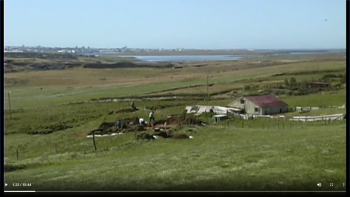
This introduces a troubling pattern, continued throughout the video, of the abstraction and removal of the audience from the archaeologist. Although much of the footage is taken either in-trench or at the trench’s edge, the archaeologist is largely depicted as an anonymous pair of hands cleaning a section (Fig. 3), or filling in a context sheet, and neither the videographer nor the featured interviewees interact significantly with these archaeologists on film.
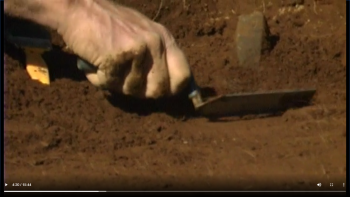
The exception to this is the six “specialists” (5’24”) who, in addition to their talking head interviews, are the only people who are deliberately recorded speaking on site. Although other voices can be heard on the recording, most notably at 2’55” when a female archaeologist can be heard pointing out a feature, they are rarely on-screen and never the centre of attention. This produces a strange dichotomy between the named experts, in the starring role, and the anonymous archaeologists - described offhand in a later segment only as “a lot of students” (5’14”) - at work in the trench itself. Whilst the specialists are developed almost as “characters,” with introductions and assigned roles (5’14” - 5’59”), the archaeologists in the field are reduced to hands or faces whose interpretations are never requested or offered. To quote Foucault, (in Wickstead 2009, 252), “[the subject] is seen but he does not see; he is the object of information, never a subject of communication.” Interestingly, several of the unnamed students are female: there is perhaps room for a broader discussion on the prioritisation of male ‘expertise’ over female experience, beyond the scope of this essay.
Throughout, although there are several scenes filmed “at the trowel’s edge,” there is little, if any, explanation of phasing or contexts - favouring shots of academics discussing possible interpretations of archaeology which the audience is never allowed to see for themselves. This is particularly noticeable at two points: scenes from 2’53”-3’47”, where the camera focuses on specialists standing trench-side and pointing at off-screen features, describing them in an unscripted conversation (Fig. 4); and 8’51”-9’18”, where a church is confidently identified, without further elucidation. This again obscures the archaeology in favour of the expert - the audience is not given the opportunity to assess the material for themselves, but only to receive wisdom from the archaeologist. This approach makes it unclear why site footage was used for these sections, rather than a continuation of the talking head approach, as there is no visible benefit to being on-site for the discussion.
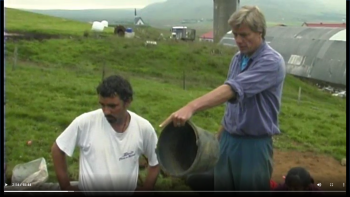
Similarly, although Byock emphasises the importance of the local community (6’15”), and indeed the importance of the site to the community, no interviews are conducted and it is unclear how much input the residents were invited to provide. The combination of these factors gives the impression of an archaeological research unit imposing themselves on the landscape without engaging critically the community or volunteers with whom they were apparently working. This is particularly interesting considering that a key point of the video is the identification of a boat burial based on phenomenology (Fig. 5); presumably the contribution of local residents who are familiar with the region not only on a geographical but also a personal level would have been relevant to this investigation. Nixon (2001, 85) presents an alternative, and more ethical, approach by ensuring that the local population involved were named and their contributions recognised, in an attempt to rectify the tradition of identifying only the directors and on-site supervisors.
Sound
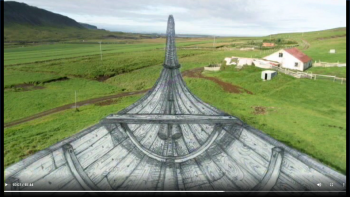
It is interesting to consider the film’s use of sound. Although large sections of the video are overwhelmed by a classical soundtrack, the on-site filming frequently features diegetic sounds of trowelling, mattocking, and wind. This is used particularly effectively when overlaid on section title cards: once the title is shown, it fades to black and the sound of trowelling begins before the site itself is seen (6’53”). This creates an auditory environment, in which the audience can imagine the activity in the trench and possibly even the weather conditions as wind is picked up by the microphone.
The use of early 20th century music in the introduction evokes a period of change; the chromatic dissonance creating a sense of unease and uncertainty, echoed visually by the misty and obscured landscape, glimpses of historical literary material, and voiceover recounting folklore. Romantic strings are used to enhance the drama of the excavation, played over a compilation of elements from de-turfing to documentation. At points, diegetic sound is audible over the musical soundtrack, creating an uneasy relationship between the documentary-style site recording and the more cinematic production values added later. This tension between fact and interpretation is carried throughout the film.
Data Transparency
The data used in this video are available in the comprehensive publications on the site, which has been active from 2003-2015 (Byock & Zori, n.d.). The viewer can access this information. However, if the audience is assumed to be viewing the video in isolation, there are several issues with data transparency. Lack of elucidation of primary sources - for example the sagas, which are alluded to but not directly cited - is compounded by use of questionable secondary sources. Maps and aerial photos of Iceland, and Mosfell specifically, are used in combination with unsourced woodcuts and paintings to demonstrate the arrival of the Vikings. This leads to some confusion in terms of which sources are directly pertinent to the site, which are historically accurate, and which are simply attractive illustrations. The assumed authority of the narration and talking heads also prevents unbiased interpretation. The approach taken is largely ‘tell don’t show,’ and it would be extremely difficult for a viewer to construct their own understanding of the archaeological material from this video.
A Panel Approach
I propose an alternative method of representing this data, in the form of a webcomic, an illustration-based narrative published online. Inspiration is taken from the open access educational comic produced by Applied Comics Etc. in collaboration with Newcastle University and The Gertrude Bell Archive, Gertrude Bell: Archaeologist, Writer, Explorer (Newcastle University/Applied Comics Etc., n.d.); and John Swogger’s Oswestry Heritage Comics (Swogger 2017).
Gertrude Bell incorporates direct links to digitised archive materials within the comic, encouraging readers to investigate the primary sources themselves (Newcastle University/Applied Comics Etc., n.d.; Fig. 6). A similar approach to an archaeological project could incorporate media including context sheets, finds reports, and historical sources, allowing the viewer to absorb the data without the enforced interpretation of the video format.
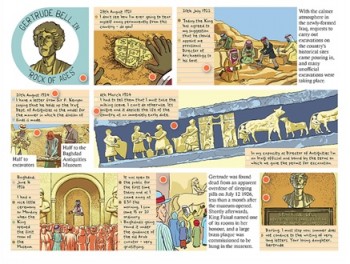
Oswestry Heritage Comics combine archaeology, local history, and heritage of the town of Oswestry, written in collaboration with local researchers (Swogger 2017; Fig. 7). This approach enables incorporation of the different groups engaging with the site, and allows for presentation of different datasets. Applied to Mosfell, it could also showcase different perspectives, particularly filling out the role of the anonymous excavator through a point-of-view character, creating a friendly interface through which visual records such as photographs and context sheets can be showcased and explained. These characters could vary throughout, incorporating the experts, the students (both American and Icelandic), the local community, and the lab technicians, depending on the subject area being covered.
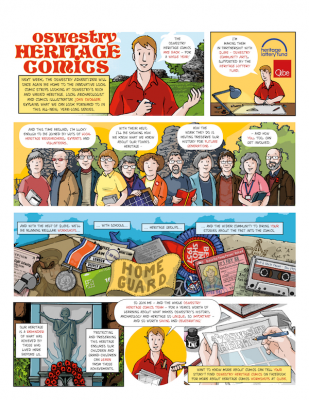
Illustration has the potential to encapsulate simultaneous processes and present “a complete package of info” (Carlson 2014, 271), demonstrating knowledge beyond perception. Struever (2009, 195) states that film has the potential to emphasise specific points and demonstrate spatial relationships which could not be shown through photography. A creative multi-panel approach in a comic could also provide these features, arguably with more clarity. Carlson (2014, 275) also notes that illustrations can pick up features too subtle to be shown on photographs: this is surely pertinent to the presentation of a site like Mosfell, where changes in soil colour, for example, could be more clearly displayed through illustration than filming.
For this reason, the style of the comic would be in a less formal, non-photorealistic style, as a stylized rendering would offer greater potential to emphasise key points which may otherwise be unclear to a casual observer. This can be demonstrated in Swogger’s (2018; Fig. 8) depiction of stratigraphy in “Heritage Under our Feet”: an instant visual communication of the concept of layers, which can then be further explored through the text boxes explaining the various finds therein. Although the artefacts may not be drawn to scale or even proportion, their meaning is clear and opens a path for further investigation. Despite Frankland’s (2012) study, which showed a clear preference for photo-realism amongst both the public and heritage professionals alike, there is a clear danger in photo-realism representing a perfect vision to the public, without thought of further interpretation. This is one of the issues with the documentary, in that the talking head and “voice of God” elements do not allow for alternative interpretations. By using a more interpretative style in the comic, it will enable a more creative and collaborative approach using illustrations as a start rather than an end point of interpretation, as suggested by Perry (2014). Showing both established archaeological facts together with suggested interpretations enables the reader to see the data and draw their own conclusions about the accuracy, or otherwise, of the interpretation.
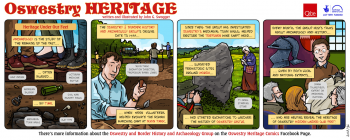
An issue in archaeological comics is their distribution. Although factually-based comics such as Kate Beaton’s vignettes on historical figures in Hark! A Vagrant (Beaton 2018) have achieved widespread acclaim and publicity through their irreverent and witty treatment of the past, archaeologically-based work such as that of Swogger is not largely featured outside of the specialist interest groups with or for whom it was created. Although Swogger’s Oswestry Heritage Comics were disseminated via Facebook, his own blog, and local newspapers (Swogger 2016), they are largely only attracting the attention of those already invested in some way in the topic, for example local residents. It is unclear how this concern can be addressed, but effective dissemination must be considered prior to the creation of the resource.
Conclusion
Many of the issues concerning Mosfell relate to concepts of authority, and who is permitted to speculate about the past. By abstracting the field archaeologists from the archaeology in which they are engaged, a kind of dissonance is created between what is and what is interpreted to be. This dissonance extends into the relationship between diegetic and external sound, the historical versus the archaeological sources, and finally the archaeologist and the audience, who are held at a distance and not trusted to form their own interpretations from evidence. The result is almost uncomfortable and certainly frustrating to watch. Using the same data to create a comic incorporating contributions from all stakeholders in the project would enable these conflicts to be, if not resolved, then at least presented equally, for the viewer to decide for themselves.


